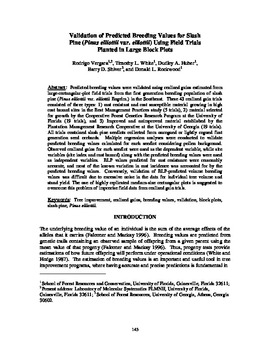| dc.contributor.author | Vergara, R. | |
| dc.contributor.author | White, T. L. | |
| dc.contributor.author | Huber, D. A. | |
| dc.contributor.author | Shiver, B. D. | |
| dc.contributor.author | Rockwood, D. L. | |
| dc.date.accessioned | 2016-04-25T19:36:02Z | |
| dc.date.available | 2016-04-25T19:36:02Z | |
| dc.date.issued | 2003 | |
| dc.identifier | oksd_sf27_p143.pdf | |
| dc.identifier.citation | Vergara, R., White, T. L., Huber, D. A., Shiver, B. D., & Rockwood, D. L. (2003). "Validation of Predicted Breeding Values for Slash Pine (Pinus elliottii var. elliottii) Using Field Trials Planted in Large Block Plots." In 27th Southern Forest Tree Improvement Conference, Stillwater, OK | |
| dc.identifier.uri | https://hdl.handle.net/11244/33681 | |
| dc.description.abstract | Predicted breeding values were validated using realized gains estimated from large-rectangular-plot field trials from the first generation breeding population of slash pine (Pinus elliottii var. elliottii Engelm.) in the Southeast. These 43 realized gain trials consisted of three types: 1) rust resistant and rust susceptible material growing in high rust hazard sites in the Best Management Practices study (5 trials), 2) material selected for growth by the Cooperative Forest Genetics Research Program at the University of Florida (19 trials), and 3) Improved and unimproved material established by the Plantation Management Research Cooperative at the University of Georgia (19 trials). All trials contained slash pine seedlots collected from unrogued or lightly rogued first generation seed orchards. Multiple regression analyses were conducted to validate predicted breeding values calculated for each seedlot considering pollen background. Observed realized gains for each seedlot were used as the dependent variable, while site variables (site index and rust hazard) along with the predicted breeding values were used as independent variables. BLP values predicted for rust resistance were reasonably accurate, and most of the known variation in rust incidence was accounted for by the predicted breeding values. Conversely, validation of BLP-predicted volume breeding values was difficult due to excessive noise in the data for individual tree volume and stand yield. The use of highly replicated medium-size rectangular plots is suggested to overcome this problem of imprecise field data from realized gain trials. | |
| dc.format | application/pdf | |
| dc.language | en_US | |
| dc.relation.ispartofseries | Sponsored publication . . . of the Southern Forest Tree Improvement Committee ; no. 49 | |
| dc.rights | This paper is made available through open access and the auspices of the fair use doctrine for scholarly, educational and research purposes while recognizing the publisher already offers a free online version. The OSU Library�s intent is to offer access and preserve publications involving its faculty contributions. Contact the Digital Resources and Discovery Services at lib-dls@okstate.edu or 405-744-9161 for the permission policy on the use, reproduction or distribution of this material. | |
| dc.source | Proceedings of the 27th Southern Forest Tree Improvement Conference, volume 27, 2003. Editor, Craig R. McKinley. | |
| dc.title | Validation of Predicted Breeding Values for Slash Pine (Pinus elliottii var. elliottii) Using Field Trials Planted in Large Block Plots | |
| dc.type | text | |
| osu.filename | oksd_sf27_p143.pdf | |
| dc.type.genre | Conference proceedings | |
| dc.subject.keywords | tree improvement | |
| dc.subject.keywords | realized gains | |
| dc.subject.keywords | breeding values | |
| dc.subject.keywords | validation | |
| dc.subject.keywords | block plots | |
| dc.subject.keywords | slash pine | |
| dc.subject.keywords | pinus elliottii | |
| dc.description.scopeandcontents | Papers and abstracts from the 27th Southern Forest Tree Improvement Conference held at Oklahoma State University in Stillwater, Oklahoma on June 24-27, 2003. | |
